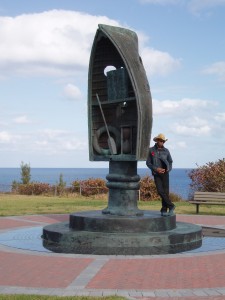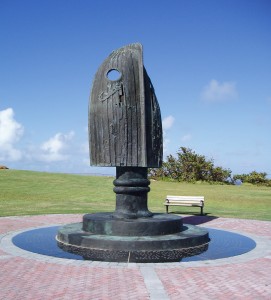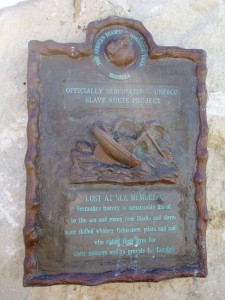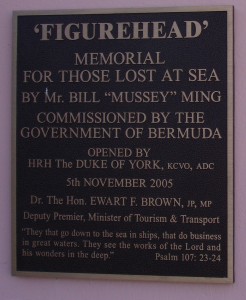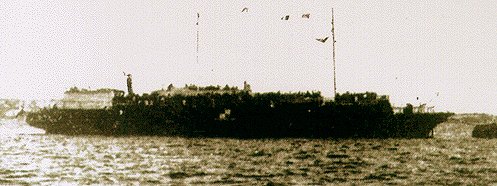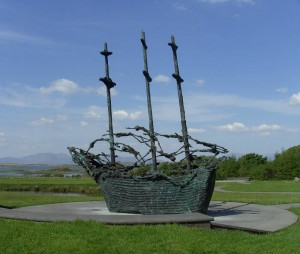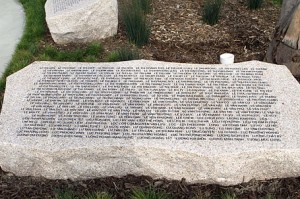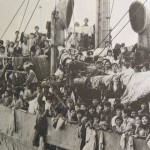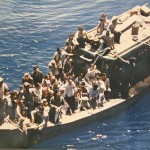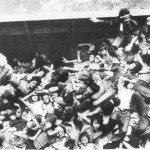Archive for the 'Refugees' Category
The most enjoyable and satisfying aspect of writing this blog is hearing from strangers commenting on a post or directing my attention to a memorial previously unknown to me. Recently I received an email from Nadia Ming, calling my attention to the Figurehead Memorial on St. David’s Island, Bermuda. My sincere appreciation to her for all the background information for this post. All Photographs in the post are courtesy of Nadia Ming.
The memorial was originally proposed in January 2003, when two fishermen were lost at sea in rough weather. The memorial, by Bermuda artist and native Bill Ming, was dedicated on November 5, 2005 by HRH Prince Andrew, the Duke of York.
I often speculate about the thought process of the artist when writing these posts. This post is special, however, as Nadia Ming provided me with Bill’s original vision for the project.
Maquette for Memorial for Those Lost at Sea
“As an ex-seaman who worked aboard the Queen of Bermuda I felt inspired and motivated to submit my representation of the Memorial for Those Lost at Sea. The theme of maritime life is very close to my art and ideas therefore this sculpture is intended to be a work of commemoration for the known and unknown souls lost to the tides of time yet alive through our memories and chronicles.
This memorial should honour our local fishermen/women who cast their nets and pots to scrape an existence from their catch. Bermudians lost to their loved ones as a result of storms or hurricane and the African slaves who perished during the long arduous Middle Passage.
I have tried to capture these elements, creating the spirit of a beacon that acts as a guiding and welcoming sight in times of storm and calm, a lookout for sailors who sail beyond that horizon of hope.
The form of my sculpture takes the shape of an upturned vessel, which points to the skies and stands erect on a compass due east. Barnacles, shells and a map of Bermuda tattoo the face/mask like limpets clinging to a hulks underbelly. These would stand proud of the surface providing tactile information for people with visual impairments.
Braids of rope frame a cabinet, which houses a paddle for that proverbial creek; an hourglass with sand running out and a life preserver to keep ones head above the water. Overseeing these articles shelters an open logbook that can display the names of all ”Bermudians lost at sea,” alternatively the base could also provide space for names, which would be visually accessible for people in wheelchairs.
I envisage that the final design could be produced in metal (possibly bronze) and/or stone, which would be sympathetic to the site and have durability.”
I believe Mr. Ming captured every element he envisioned in this beautiful memorial. The artist is pictured in the first picture below. I encourage everyone to learn more about Mr. Ming and his art at: http://www.billming.com/index.php
Nadia pointed out two very important additional elements of the memorial in her emails. The first was that The Figurehead Memorial is also part of The African Diaspora Heritage Trail (ADHT), which has been officially designated part of UNESCO Slave Route Project. Take the time to visit the ADHT website at: http://www.adht.bm. I think you will find yourself, like me, spending many fascinating hours learning about “the global narrative of people and culture of African descent” – and the very valuable and important effort to encourage everyone to visit these sites of historical and cultural importance and enrichment.
Information on the UNESCO Slave Route Project can be found at :http://www.unesco.org/new/en/culture/themes/dialogue/the-slave-route.
Men and women of African descent have sailed the oceans since the beginning of recorded history. The earliest known ocean voyages were from Northern Africa to Malta and Crete. During the Great Age of Sail (1600 – 1850) over 20% of all able-bodied seamen were of African descent – some were slaves, but most were free Blacks. Today they still command and crew the warships, merchant vessels, passenger ships and fishing fleets of the world – and daily face the dangers and the majesty of the open ocean.
Approximately 70 names of those lost at sea from Bermuda are engraved at the base of the memorial. All their names can be found at: http://bernews.com/2010/03/lost-at-sea-memorial-full-list-of-names/.
In closing this post, the poem below is inscribed in the open pages of the logbook on the memorial. The poet’s words were inspired by the book of Revelations of St. John the Divine, Chapter 10:5,6 – “And the angel whom I saw standing on the sea and upon the earth lifted up his hand to heaven. And swore by him that liveth for ever and ever, who created heaven and the things that are in it, and the earth and the things that are in it, that time should be no longer.”
THE END OF TIME
“Upon the restless rolling deep
That once the mighty tempest spawned;
Now lies the racing crest asleep.
Beneath that peaceful glassy plain;
All ships and men are there interred;
And all are ‘neath that blanket lain;
Tho’ strove with main now undisturbed.
Beneath that awful silent shroud;
Beneath that fearful mocking stew;
Mingled bone and steel as one
Forever wed as silten brew.
Wreckage, war and nature’s knife;
Trophies piled are theirs to be;
But wills again ‘lasting life,
Victorious, glorious, – NO MORE THE SEA”
By the late Allan E. Doughty Sr. 1922-2013
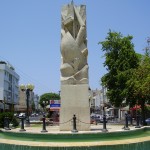
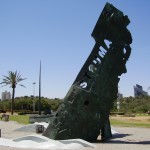 The waters of the world contain the bodies of countless refugees. Quite often these seem to be the saddest of the stories of those lost at sea. Hopeless situations throughout history have led refugees to flee their homelands, only to find death instead of a rebirth.
The waters of the world contain the bodies of countless refugees. Quite often these seem to be the saddest of the stories of those lost at sea. Hopeless situations throughout history have led refugees to flee their homelands, only to find death instead of a rebirth.
The SS Struma was a ship chartered to carry Jewish refugees from Axis-allied Romania to British-controlled Palestine during World War II. The Struma voyage was one of several attempts by Zionist organizations to create a workable escape route for Jews from Eastern Europe – first to neutral Turkey via the Black Sea, then from Turkey to Palestine via land or sea.
The Jewish refugees on the Struma were mostly wealthy Romanian Jews who could afford the high price of their escape. What they found when they boarded the ship in Constanza, Romania in December 1941 was basically a derelict – a 180-ton two-masted vessel that had once been used to haul cattle on the Danube. There were approximately 770 people crowded into a space that could hold perhaps 100. There was one bathroom. The ship had wooden platforms built on the deck to allow more people to be transported. After three days at sea the engines failed and the vessel was towed into Istanbul. That’s when the real nightmare began.
For the next 71 days the ship lay at anchor, the refugees not allowed to leave. Food and water were provided by Jewish relief organizations. During this time secret negotiations were conducted between the Turks and British on the fate of the passengers. The British would not give the refugees entry papers into Palestine – fearing more violence in the Middle East if they did not restrict massive Jewish immigration. The Turks were neutral in the war at this time, and were a trading partner of Nazi Germany. They did not desire to become the conduit for Jewish refugees fleeing the Nazis.
On February 23, 1942 the Turks apparently believed that an impasse with Britain had been reached. They decided to rid themselves of the situation completely. Turkish authorities boarded the disabled ship and towed it through the Bosphorus strait to a site ten miles away in the Black Sea. The Turkish authorities then abandoned the ship with over 760 refugees and crew aboard. Without power for propulsion or food or water – the Struma, her crew, and over 750 refugees drifted on the Black Sea. On the morning of February 24, 1942 the Soviet submarine SC-213 torpedoed the Struma. The vessel sank almost immediately – at least 768 people died, including over 100 children. The Soviet submarine was under orders to sink any unidentified vessel to keep war materials from reaching Germany. Only one man survived the sinking of the Struma – a 19-year-old man named David Stoliar. Type Mr. Stoliar’s name into a search engine. The leading results will take you to video and audio histories he has recorded concerning his experience on Struma and his life after the incident. They are fascinating and horrifying. He presently lives in Oregon.
The two monuments shown above are found in Holon, Israel and Ashdod, Israel. I’ll cover an Israeli monument to another ill-fated refugee ship in a later post.
War always results in tragedy, but this is one that is difficult to comprehend and accept. Political considerations guided the ill-fated decisions of the British, the Turks, and the Soviets. But like many decisions guided solely by political considerations, basic humanity is somehow lost in the equation. What all too often results when politics trump basic human morality is the deaths of the most innocent…
If you research the history of Ireland you will read much about the Great Famine of 1845-1852. The potato blight resulted in the deaths of an estimated one million people on the island itself. Another one million people left their homeland to relocate to America, Canada, Australia and other places of refuge around the globe. Many of those fleeing an existence of starvation sailed on what would become known forever in Ireland as Coffin Ships. They were accurately named by history. The mortality rate on these ships was often 30% or more. Tens of thousands of Irish rest on the bottom of the world’s oceans, their lives extinguished by ruthless shipowners and unscrupulous shipmasters.
‘Coffin Ships’ as a nautical term is not used strictly in association with the Irish Famine. In the lore of the sea it describes any vessel that has been overinsured, basically making it worth more to its owners at the bottom of the sea than afloat. But coffin ships became a routine hell for the Irish leaving their island during what the Irish call “The Great Hunger”. Lack of food and water, disease, and unsafe vessels led to countless journeys of misery and death. Many accounts routinely mention sharks following the ships, because so many bodies were thrown overboard during these voyages.
The Irish Government commissioned a monument to the lost souls of these voyages to mark the 150th anniversary of the Irish Famine. The haunting sculpture, by artist John Behan, depicts a coffin ship with rigging of human skeletons and bones. It is Ireland’s largest bronze sculpture and was unveiled in 1997 by Mary Robinson, the then President of Ireland. Mr. Behan’s piece, especially when viewed up close, is a work of incredible power and complexity. It is unforgettable.
I’m including two interesting links to help you appreciate the sculpture and the story of the Coffin Ships. The first link will take you to a FLICKR photo stream by Dave Bushe. Scroll through his dozen or so beautifully detailed photos of the sculpture. The other link is to a fascinating YouTube video detailing the memorial and excerpts from a diary of a voyage to Canada during the famine years.
http://www.flickr.com/photos/davebushe/50973869/in/photostream/
http://il.youtube.com/watch?v=TZIjZkiYGhI&feature=related
Translate the word into any language and it will still convey the same sobering image of a person on a long journey, fraught with hardship and danger, a long trek towards an uncertain future. Refugees have fled war, persecution, and natural disasters via the oceans for as long as boats have challenged the seven seas.
During 1975, as a U.S. Naval Officer stationed in the South China Sea, I witnessed a small part of the human drama of the Vietnamese Boat People. It was not an easy thing to see – an impossible thing to forget. With the fall of Saigon on April 30, 1975, hundreds of thousands of Vietnamese crowded into every type of boat imaginable and fled their homeland. This exodus continued for years. They sailed towards Malaysia, Thailand, the Philippines, Hong Kong, and Indonesia. They sailed on overloaded vessels, many boats totally ill-equiped for the open ocean. Most refugees were rescued – initially moved to relocation camps in Asia, and eventually resettled permanently in strange countries of the Western World – the United States, Canada, Australia, the United Kingdom, Germany, France, Israel, and others. For thousands of Vietnamese refugees, however, their journeys ended in death – their bodies scattered on the ocean floor of the vast expanse of the South Pacific.
Cam Ai Tran and Hap Tu Thai and their two children escaped Vietnam by boat in 1979. Thirteen others on the same boat died and were buried at sea. Tran and Thai are now the publishers of the “Saigon Times”, based in Rosemead, California. For ten years they worked tirelessly to build a memorial to the Boat People, including the tens of thousands who died at sea. In the Spring of 2009 the Vietnamese Boat People Monument was dedicated in Westminster Memorial Park’s Asian Garden of Peaceful Eternity.
The main focus of the monument contains four statues on a slab within a pool, the slab resembling a raft. The figures on the raft are of a man, an older woman, and a younger woman holding a young child. The design is by Vietnamese artist Vi Vi. Surrounding the memorial are 54 blocks of stone, on which are engraved the names of over 6,000 deceased boat people, of which many thousands were lost at sea.
Please use the link below to visit the “Saigon Times” English translation. On the far left of their home page you will find links to many compelling stories of the Vietnamese Boat People. Start your visit by scrolling to the very bottom link on the left side. This link will take you to a page with many fine photographs detailing the design and construction of this beautiful memorial. The memorial’s total area is quite extensive, with the overall design shaped like a ship’s hull.
Like all good memorials, the Vietnamese Boat People Monument tells a compelling story. This is a story with many chapters – chapters detailing suffering and fear and sometimes death – but chapters that just as often end in survival against all odds, and in redemption…
http://translate.google.com/translate?hl=en&sl=vi&tl=en&u=http%3A%2F%2Fsaigontimesusa.com%2F

